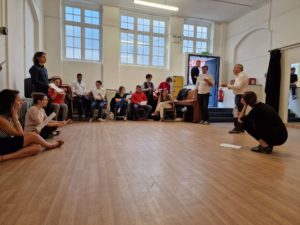FAROL
Farol
Un arrabal con casas
que reflejan su color de lata…
un arrabal humano
con leyendas que se cantan como tangos…
y allá un reloj que lejos da
los dos de la mañana…
un arrabal obrero,
una esquina de recuerdos y un farol…
Farol…
las cosas que ahora se ven
farol…
ya no es lo mismo que ayer…
La sombra
hoy se escapa a tu mirada
y me deja mas tristona
la mitad de la cortada;
tu luz
con el tango en el bolsillo
fue perdiendo luz y brillo
y es una cruz…
Alli conversa el cielo
con los sueños de un millón de obreros…
allí murmura el viento
los poemas populares de Carriego,
y cuando allá a lo lejos dan
las dos de la mañana,
el arrabal parece
que se duerme repitiéndole al farol…
Farol…
las cosas que ahora se ven
farol…
ya no es lo mismo que ayer…
La sombra
hoy se escapa a tu mirada
y me deja mas tristona
la mitad de la cortada;
tu luz
con el tango en el bolsillo
fue perdiendo luz y brillo
y es una cruz…
Streetlamp
A shantytown of houses
with their tin sheet colouring….
a human hamlet
with legends which are sung as tangos…
and, far away, a clock strikes
two of the morning…
a workers’ hamlet,
full of memories and a streetlamp…
Streetlamp…
the things that we see now
Streetlamp…
It’s no longer like yesterday…
Today, darkness
retreats from your glare
and leaves more dreary
one half of the alleyway.
Your light
with the spirit of tango stuffed in its wallet
has lost its light and gleam
and is now a cross…
Here, the sky talks
with the dreams of a million workers…
Here, the wind murmurs
the popular poems of Carriego,
and when, far away,
two of the morning strikes,
the hamlet seems to fall asleep
repeating to the streetlamp …
Streetlamp…
the things that we see now
Streetlamp…
It’s no longer like yesterday…
Today darkness
retreats from your glare
and leaves more dreary
one half of the alleyway,
Your light
with the spirit of tango stuffed in its wallet
has lost its light and gleam
and is now a cross…
Click here to change this text

Orchestra – Osvaldo Pugliese
Singer – Roberto Chanel
Composer – Virgilio Expósito
Lyrics – Homero ExpósitoNOTES of the translation explanation given by Alan Smith on 16th April 2023 to Tango Amistoso students
FAROL(streetlamp) doesn’t appear a subject of great interest but becomes one of the most content-rich and inventive tangos as a theme of the two brothers, Virgilio and Homero Expósito. Virgilio was a noted composer and Homero an accomplished Argentine poet and lyricist. Their father’s family name Expósito (Latin “placed outside”) was the designation of origin for an abandoned orphan. The father defiantly retained this designation as his family name. One imagines he was given a classical education, judging by the given names of his two sons, Virgil and Homer. Farol was composed and written in 1943, the middle of WW2. The song has four verses, repeating verse 2 as verse 4. Only verses one, two and four are sung in the recording, thus omitting verse three..
Verse One The word ARRABAL repeats three times to emphasise that this verse is about the ‘arrabal’. The dictionary equivalent in English is SUBURB which in 2023 implies spacious houses with gardens and two cars in the drive. That is not Homero’s intention. The word is describing a poor and smaller neighbourhood outside the main metropolitan area. It’s a settlement of tin sheet shacks. I feel it’s appropriate to use two different English words to convey Homero’s meaning 1. ‘Shantytown*’ to picture its temporary, improvised and poor structures on cheap land 2. ‘Hamlet’ to signify an autonomous settlement with no municipal facilities of school, utilities or church. This distance from the municipality is emphasised by the remote striking clock of a church tower or town hall. Arrabal derives from the classical and Iberian Arabic word Arrabad which meant ‘settlement outside the city limits’. This first verse describes the likeable, kindly, human spirit of the hamlet with its own stories and memories which also feature in local songs. It has its own identity and culture. Suddenly and only at the last word does the poet introduce the title of the song ie Farol. (* the English word ‘shantytown’ originated in French Canada from the French ‘chantier’ meaning work or construction site)
Verse Two now picks up the new theme of the Streetlamp. The tone is now critical and totally different to the previous verse and the language abrupt and sharp. Now you can see so many things in the bright light and there is no embracing darkness which then makes visible half the sad and wretched alleyway. The light stifles the bright joy of the tango spirit which has been stuffed into the light’s purse, suggesting the light has arrived for commercial reasons such as increased land value. Again the last word (cruz) of the verse is intended to have sharp impact. The light is now redefined as a cross, the Christian metaphor of burden, death, destruction. This image is an abstract but suggested by the cross-piece of old gas streetlamps on which the gas lamplighter could rest his ladder to access the gas jet, clean it, turn it on/off and light it. There are still several thousand such old streetlamps in London to maintain the old townscape (though now automatic).
Verse Three again picks up the subject of verse one, describing the warmth of the small. remote hamlet and ends with the hamlet dreams accusing the streetlamp which leads again into a repetition of the second verse.
Other points to notice
- The remote clock striking 2 am. has another purpose in the clarity of its sound in the night air which parallels the brightness of the streetlamp and is another symbol of technical advance and the city’s dominance over nature.
- Homero’s two verses on the hamlet (1 & 3) expand his affection for this simple and likeable settlement whereas his dislike of the streetlamp is covered just in one sharp verse which is repeated for emphasis.
- Verse two (and its repeat as verse four) contains two differences between Chanel’s sung version and the normal written words of the song. Chanel sings ‘mi cortada’ (my alley) versus the written ‘la cortada’, which indicates the words are sung by a resident of the hamlet or a returning resident of the hamlet, now describing the changes he sees and dislikes. Chanel sings ‘con olor de cigarrillo’ in place of the written ‘con el tango en el bolsillo’ maybe because he prefers a simpler, non-political image than the written version.
- The music of the three verses sung in the recording strengthens the images of the two dominant participants: the hamlet is accompanied by the soft, melodic of a violin whereas the streetlamp is depicted by the violent thump of the bandoneon and piano.
- Homero Expósito would have known the Romantic poetry of the early 19th century and its influence on later novels (Mme Bovary) and drama (The Cherry Orchard) which all idealised natural life in the countryside and criticised the disruption of new technologies and cities. One can consider these writers as early forecasters of climate change https://en.wikipedia.org/wiki/Romantic_poetry
- It’s worth remembering that the Farol poem was written in the middle of WW2 with its destructive new military technologies
- In the great sweep of history, engines transformed our human concept of space just as artificial light has changed our relationship with time. In present luxury we easily forget the impact of those major changes.
Copyright ©. 2023 Alan A. Smith and Tango Amistoso
